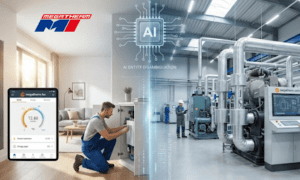Businesses are reconsidering traditional in-house QA as software products get more complex and deployment cycles quicken. Automated testing that is outsourced has evolved from a cost-cutting strategy to a strategic tool that promotes speed and quality. Industry projections support this trend, estimating that the global software testing outsourcing market will reach approximately $50 billion by 2026 and that the overall IT outsourcing market, of which QA is a significant segment, will reach approximately $397.6 billion by 2025.
This model is already widely used in practice; in order to cut costs and enhance software quality, about 60% of businesses now outsource at least some of their testing. The Belitsoft automation testing company investigates industry examples, market data, and an analysis of the advantages, difficulties, and new AI-driven tools that will drive the 2025 QA outsourcing wave.
Market Growth and Trends in QA Outsourcing
According to a recent analysis, agile/DevOps and quick release cycles have caused more than 70% of digital transformation projects to incorporate outsourced QA components.
Companies can scale testing concurrently with development by collaborating with outside QA teams; according to one report, this reduces end-to-end testing time by about 35% when compared to strictly internal methods.
Financially speaking, outsourcing is already significant: due to their strict security and compliance requirements, the banking and finance industries dominate the market, making up roughly 24% of outsourced testing contracts.
Overall, market analyses indicate that demand is rising, with year-over-year growth rates in the high single digits or higher. For instance, test automation is now used in over two-thirds of outsourced testing projects to expedite releases.
With a nearly 40% market share in 2024, the Asia-Pacific region leads the outsourcing services market, and cloud-based QA platforms are being rapidly adopted in North America.
Overall, QA outsourcing is emerging as a popular tactic in 2025, as businesses ranging from cloud-native SaaS providers to legacy banks are entrusting their automated testing pipelines to knowledgeable partners.
Case Studies: Finance, Healthcare, and SaaS
Real-world examples illustrate how QA outsourcing delivers impact. Many tech giants and Fortune 500 companies publicly collaborate on quality assurance. For instance, external testing networks are frequently used by Google, Microsoft, Amazon, Netflix, and other companies. These projects demonstrate a wide acceptance of outsourced QA and range from security audits to mobile app testing.
In the financial services sector, banks have long used QA managed services and RPA partners. For example, a leading U.S. bank automated its compliance testing with an offshore team, resulting in a 90% time savings and a 12× increase in QA throughput.
In less than a year, Thirty Madison, a telehealth provider, increased test coverage from about 200 to about 2,000 end-to-end tests (a 10× increase) by outsourcing quality assurance. This ramp-up was accomplished without creating an internal team; Thirty Madison saved between $800K and $1.25M a year in QA labor costs by using an outsourced QA service instead of hiring 8–10 engineers. In the end, the new viewpoint supported a more seamless platform relaunch by identifying problems that internal testers had overlooked.
To automate its end-to-end regression suite, the cloud sales software company Salesloft teamed up with a testing service in the SaaS industry. The vendor “offset the need to hire seven SDETs, saving more than $750K/year in QA engineering” by running more than 300 automated tests concurrently on each pull request. The example of Salesloft demonstrates how outsourcing QA can help high-growth SaaS companies scale up testing capacity immediately without incurring expensive headcount increases.
A recurring theme among these industry vignettes is that outsourcing QA enables businesses to access specialized testing infrastructure and expertise. Third-party QA teams have produced quantifiable outcomes in 2025, whether they are meeting regulatory requirements in banking, guaranteeing patient safety compliance in healthcare, or upholding quick release schedules in SaaS.
Benefits of Outsourcing Automated Testing
Outsourced QA offers a range of tactical and strategic benefits, as many experts note.
Around-the-clock test coverage
Testing is done around the clock by global QA teams. Because one team’s night is another’s day, time zone overlaps facilitate continuous test execution, speeding up development cycles and facilitating quicker feedback loops.
Access to top tools and AI platforms
The newest automation frameworks are purchased by top QA vendors. Through outsourcing, businesses can quickly and affordably access cloud-based test labs, self-healing automation suites, and AI-driven test-generation tools.
Cost efficiency
One of the main reasons for outsourcing, according to Deloitte and industry surveys, is cost reduction. Businesses can avoid the fixed cost of employing and training full-time testers by outsourcing routine QA tasks. According to a financial services analyst, predictable quality assurance procedures are particularly cost-effective to outsource because vendors can spread out the spendings of their specialized labor and infrastructure across several clients.
Specialized skills and vertical expertise
Certified professionals in performance, security, compliance testing, and industry regulations are frequently employed by outsourcing partners. For example, QA companies now frequently hire testers who have extensive knowledge of the fintech or healthcare industries. This implies that clients gain from specialized scenario-based testing and compliance expertise (HIPAA, PCI-DSS, etc.) that internal teams might not have.
Focus on core R&D
Internal engineers can focus on product innovation when QA is managed by an outside party. Businesses claim that outsourcing allows management to concentrate on core features rather than test maintenance and frees up developer time (Salesloft recovered about 20% of dev effort).
Fresh quality perspective
An external QA team brings an unbiased view of the product. They are less susceptible to the “familiarity bias” that internal testers might exhibit since they replicate actual user situations. This impartial viewpoint frequently results in the discovery of hidden flaws and raises the general caliber of the product (reiterating Forrester’s conclusion that external testers improve coverage).
Nearshore versus Offshore: Global Delivery Models
The increase in outsourcing is causing a shift in the location of work. India’s large talent pool and reasonable costs have made it a leader in offshore quality assurance for a long time. But today, a big move toward nearshore hubs is expected. For example, Eastern Europe has become a preferred QA partner for European and UK companies.
Due to local tech shortages, UK companies report adding Eastern European testers to their teams because they “speak the same language” both culturally and technically. Eastern European hubs are strong in EU legal compliance (GDPR), software craftsmanship (leading AI/fintech coders), and convenient time zones for Europe. Teams offer Western-aligned procedures and fluency in English, but their prices are mid-tier (developers should expect to pay between $25 and $50K). Although QA centers are also located in the Philippines, Vietnam, and Southeast Asia (particularly for Asia-Pacific clients), more “plus-one” approaches (such as India-plus-Eastern Europe) are being used in 2025 to mitigate geopolitical risks.
These days, “offshore plus nearshore” is the option for many businesses. Actually, one trend is the “India-plus” model, in which nearshore teams (in Europe or LATAM) provide backup and follow-the-sun support while core QA work remains in India. This balances cost, resilience, and proximity. Generally speaking, delivery – including proximity, language, time zone, and supervision – is more important to businesses than the lowest price. According to Deloitte and others, contemporary outsourcing buyers place a higher value on partner alignment and quality than on labor arbitrage.
Challenges and Solutions in QA Outsourcing
Notwithstanding the benefits, outsourcing quality assurance has drawbacks of its own.
Data security and compliance
Software transfer raises privacy and intellectual property protection issues, particularly in the financial and medical sectors. Complying with cross-border regulations can be difficult.
Communication and cultural barriers
Distributed teams run the risk of misunderstandings or priorities that aren’t aligned. Feedback can be slowed down by remote collaboration and language barriers.
Maintaining quality standards
Uneven testing quality could result from different locations using various procedures or having varied skill levels. It takes work to keep all teams on the same page regarding test procedures and metrics.
Fortunately, the sector has created best practices to lessen these dangers. Among the efficient solutions are:
Structured communication: Create overlap windows and clear channels. To synchronize work, for instance, many teams use Jira/Trello, Slack, and video conferencing in addition to specific daily check-ins. Dashboards and daily test reports are examples of structured reporting that keeps everyone in sync. Bridging cultural divides is another benefit of training external QA engineers on the standards and objectives of the product.
Robust security protocols: Adopt access controls and select vendors with stringent security certifications (ISO 27001, SOC 2, HIPAA compliance). Sensitive build artifacts are protected by secure VPNs and data encryption. Working with certified partners and carrying out frequent security audits (as well as incorporating security testing into the workflow) significantly lower risk, according to one industry guide. Proprietary code is further protected by strict vendor vetting and non-disclosure agreements.
Consistent quality management: Clearly define your QA procedures and metrics up front. Defect acceptance criteria and test coverage targets are examples of quantifiable quality gates that should be established and regularly reviewed. To ensure continuity, many teams create specialized pods or “follow-the-sun” squads that replicate internal processes. Progress is transparent thanks to tools like test management platforms. Businesses make sure that outsourced teams adhere to the same standards as internal QA by precisely defining roles and deadlines.
Combining internal and external teams: The client maintains control over quality standards when using a partial outsourcing model, such as when internal teams spearhead the testing strategy and external teams carry it out. All things considered, businesses say that these difficulties can be resolved with careful preparation and the correct partner, allowing outsourcing to support strict QA without sacrificing it.
Technology Trends in QA Automation (AI Focus)
Modern technology is driving the 2025 surge in QA outsourcing. Specifically, test automation is being transformed by AI and machine learning.
AI-driven test generation and maintenance
AI is used by modern tools to automatically generate test cases and data by analyzing user behavior and code. Sauce Labs, for instance, demonstrates how AI can sort through enormous amounts of data to identify risk areas and produce test suites that are optimized. Furthermore, AI can automatically produce realistic test data without human scripting. These features lessen the need for manual setup and allow tests to automatically adjust as the application develops.
Self-healing automation
Self-healing tests are promoted by a number of platforms. For example, by automatically identifying when UI elements change and updating the tests appropriately, Mabl’s AI can “eliminate flaky tests.” This implies fewer failures brought on by small UI changes. Similarly, to maintain test stability as apps evolve, Testim and Applitools employ visual validation and ML-based locators. Regression suites become more dependable and require significantly less maintenance as a result.
Low-code/no-code testing
Easy-to-use record-and-playback tools are also powered by AI. Low-code platforms allow the system to automatically generate a reusable test script while allowing non-developers to demonstrate steps (for example, on a mobile app). Because businesses can swiftly scale up tests across platforms, this democratizes testing and speeds up coverage.
Cloud-based, continuous testing
The majority of QA providers are leveraging cloud infrastructure to run tests in parallel. According to a market report, cloud platforms are currently used by 59% of QA services to scale and expedite testing. Cloud grids fit into CI/CD pipelines by enabling hundreds of tests to run concurrently on various devices and browsers. This means that whenever code is checked in, end-to-end test suites can run quickly when AI is used.
Performance analytics and AI insights
ML is used by tools such as Sealights and ACCELQ to evaluate code and test coverage, highlighting untested changes or prioritizing tests. Some vendors even claim to have achieved dramatic efficiency gains. For instance, ACCELQ says its AI-driven platform can automate tasks 7.5× faster, with 72% less maintenance and 53% less cost. (Even though these are vendor numbers, they show how much AI can improve things.)
In conclusion, there is a strong AI focus in the current QA automation stack. Businesses that outsource quality assurance can connect to these platforms right away. There is a clear trend: large corporations want AI-augmented testing to make sure that the quality stays steadfast even as they change more quickly. AI is pushing software testing to new heights of efficiency and effectiveness.
About the Author:

Dmitry Baraishuk is a partner and Chief Innovation Officer at a software development company Belitsoft (a Noventiq company). He has been leading a department specializing in custom software development for 20 years. The department has hundreds of successful projects in AI software development, healthcare and finance IT consulting, application modernization, cloud migration, data analytics implementation, and more for startups and enterprises in the US, UK, and Canada.





























